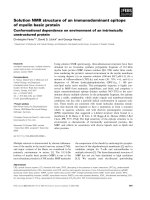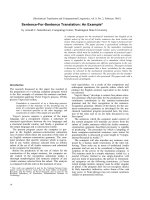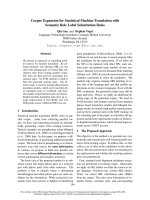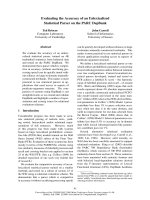Báo cáo khoa học: "TRANSFORMING ENGLISH INTERFACESTO OTHERNATURALLANGUAGES: AN EXPERIMENT WITH PORTUGUESE GABRIEL PEREIRA LOPES " potx
Bạn đang xem bản rút gọn của tài liệu. Xem và tải ngay bản đầy đủ của tài liệu tại đây (277.77 KB, 3 trang )
TRANSFORMING ENGLISH INTERFACES TO OTHER NATURAL LANGUAGES:
AN EXPERIMENT WITH PORTUGUESE
GABRIEL PEREIRA LOPES (1)
Departamento de Matem~tica
• Instituto Superior de Agronomia
Tapada da Ajuda - 1399 Lisboa Codex, Portugal
ABSTRACT
Nowadays it is common the construction of
English understanding systems (interfaces) that soo-
ner or later one has to re-use, adapting and conve~
ting them to other natural languages. This is not an
easy task and in many cases the arisen problems are
quite complex. In this paper an experiment that was
accomplished for Portuguese language is reported
and some conclusions are explicitely stated. A know
ledge information processing system, known as SSIPA,
with natural language comprehension capabilities
that interacts with users in Portuguese through a
Portuguese interface, LUSO, was built. Logic was u-
sed as a mental aid and as a practical tool.
I. INTRODUCTION
The CHAT-80 program for English (Warren &
Pereira, 1981; Pereira, 1983) was transformed and a
dapted to Portuguese. Logic Programming as a mental
aid, and Prolog (Coelho, 1983; Clocksin & Melish ,
1981) and Extraposition Grammars (Pereira, 1983) as
practical tools, were adopted to implement a natu-
ral language interface for Portuguese. The interfa-
ce here reported, called LUSO, was then coupled to
a knowledge base for geography, an extension of the
CHAT-80 knowledge base. In an ulterior experiment ,
LUSO dictionary was augmented with new vocabulary
and LUSO was coupled to other modules that conside-
rably augmented the expertise capabilities of SSIPA
(Sistema Simulador de um Interlocutor Portugu~s Au-
tom~tico (2)).
SSIPA is a complex knowledge information processing
system with natural language comprehension and syn-
thesis capabilitites that interacts with users in
Portuguese due to the linguistic knowledge that is
logically organized and codified in the above men-
tioned SSIPA's interface ca]led LUSO.After the first
step of its development, SSIPA was able to answer
(1) Present Adress: Centro de Inform~tica, Laborat5
rio Nacional de Engenharia Civil, lOl, Av. do Bra=
sil, 1799 Lisboa Codex, Portugal
(2) Simulating System of a Portuguese Automatic In-
terlocutor.
questions about geography and could agree or disa-
gree with the opinions stated by the users about
its geographical knowledge. After the second step
of its development SSIPA became more powerful and
intelligent because it could also perform actions
that traditionally were attributes of computer mo-
nitors (Lopes & Viccari, 1984).As a matter of fact,
SSIPA can create and delete files, fill them,
change their names, list and change their, contents;
SSIPA receives, keeps and send messaqes
answers questions not only about geography but
also about the knowledge SSIPA represents; it a -
grees or disagrees with the opinions stated byusers
about the Knowledg~ context behind dialogues,
reacts when users try to cheat it but, as a rule,
SSIPA behaves as a helpful, deligent and cooperat~
ve interlocutor willing to serve human users, chan
ging from one to another topic of conversation and
developing intelligent clarification dialogues (Lo
pes, 1984). All these features require a very power
ful Portuguese language interface whosemain moron~
-syntactic features are pointed out in this pa-
per.
2. FORMALIZATION OF NATURAL
LANGUAGE CONSTRUCTS
Natural language are complex structured
systems difficult to formalize. Formalization can
be understood as a step by step construction of a
theory to achieve , as an ultimate goal, an axioma
tic definition of natural language constructs. If
this descriptive theory can also function as the
linguistic structured knowledge necessary to simu-
late a human native using his mother language then,
the formalization effort has acquired and gained a
new insight. While representing a natural language
system, it may represent a native competence about
his mother language and, simultaneously, it mayper
form the role of a native using that competence.
This dual unity, incorporatingadescription of lin
guistic knowledge and incorporating the same lin -
guistic knowledge ready to be active, is central to
this work.This unification in the same unit of two
apparently conflicting and contraditory aspects of
natural languages is possible due to the usage of
logic as a mental and a practical tool. SSIPA enca
psulates both views of natural language.
Practice demonstrates that, for the cons
truction of complex models it is better to begin
with simple model versions to represent the system
one intends to simulate. This practical conclusion
8
seems reasonable because knowledge about a system
and about its representation keeps on augmenting as
far as, to achieve the validation of the simula -
ting model, empirical investigation progresses(Klir,
1975). However one must be aware that while Know -
ledge about a real system keeps on growing so do
the complexitythat one can unwillingly introduce in
to the model. Having all this in mind, if we want
to formalize linguistic knowledge about natural fan
guage we must be prepared to use powerful formal-
languages prone to description of complex systems
and able to be used as programming languages. Here
it is subsumed that computers are tools adapted to
deal with complexity, augmenting considerably hu-
man capabilities to handle highly complex represen
tational systems.
3. LUSO
LUSO input subsystem is a device that
transforms a sequence of words morfologically, syn
tactically and semantically significant into a Lo-
gical Form. A Logical Form is here understood as a
sequence of predicates, envelopes for knowledge
transportation from users to SSIPA central proces-
sing unit (the EVENT DRIVER) and from this unit to
users. These predicates generalize and augment the
potencialities of Pereira's equivalent predicates,
(Pereira, 1983). They can also be compared with the
lexical functions of Bresnam (Ig81). However we
don't use case classification. In Portuguese, pre-
positions associated to noun semanticfeatures seem
to be enough to identify and differentiate mea-
nings of verbal, noun, adjectival and even prepos~
tional form functions (Lopes, 1984).
LUSO is a natural language interface that
concentrates linguistic expert knowledge about Pot
tuguese language.
LUSO input subsystem works sequentially.
In a first step it performs the syntactical analy-
sis of an input Portuguese sequence of words. De-
pending on the task LUSO has been commited to per-
form, a lexically filled syntagmatic marker or a
failure is the result of LUSO eagerness to prove
the above mentioned input sequence of words as a
syntactically correct yes-no question, wh-question,
imperative or declarative sentence, or as a syntac
tically correct noun phrase or prepositional phra Z
se. When a lexically filled syntagmatic marker is
obtained, it is translated to a logical form. Fi-
nally this form is planned and simplified accor -
ding to the methodology described by Pereira (1983)
and Warren (1981).
The design of LUSO input subsystem re -
flects the following hypothesis:
• morphological analysis of Portuguese
constructs is syntactically driven;
• linguistic semantic analysis of Portu-
guese constructs is lexically (functio
nally) driven (in a quasi-bresnamian,
sense (Bresnam, 1981; Pereira, 1983;Lo
pes, 1984));
• cognitive semantic analysis of Portu -
guese constructs depends on syntacti -
cal and linguistic semantic analysis
previously achieved for Portuguese cons
tructs.
This suggests SSIPA as a formal system
that already theorizes some aspects of Portuguese
language while LUSO specificates the form of for-
mal functions whose cognitive content and formal ap
titude for transforming system state are defined at
the semantic level of the formal system.
To complete the formal role wewanted SS !
PA to play, LUSO output subsystem synthesizes Por-
tuguese noun phrases, prepositional phrases or se D
tences whenever it receives correspondent requests
to output such constructs. To achieve that goal LU
SO transforms any previously lexically filled syn-
tagmatic marker into a sequence of Portuguesewords
in its final forms, ready to be sent to a user.
4. MORPHO-SYNTACTICAL ANALYSIS AND SYNTHE -
SIS OF PORTUGUESE LANGUAGE CONSTRUCTS
The morpho-syntactical analysis of Portu
guese language constructs is application indepen -
dent and is based on the various concepts develo-
ped by Chomsky and followers in the framework of
the Extended Standard Theory of Generative Grammar
(Chomsky, 1980, 1981a, 1981b; Rouveret, 1983 and
many others)• As it was already mentioned in this
paper, one of the crucial hypothesis behind LUSO's
design reflects the idea that morphological analy-
sis of Portuguese constructs is syntactically dri-
ven. This means that when the syntactical parseris
waiting for a specific grammatical category, it ta
kes the next word to be analysed from the input se
quence of words and searches the dictionary for that
category, trying to find the input word. If the i
put word does not match any dictionary entry for
that particular category, all possible input word
endings, one after another, starting from the lon-
gest towards ths shortest, are matched against the
ending entries for that category until a success -
ful match will occur. If such a match does not suc
ceed, this means that the input word does not be-
long to the foreseen grammatical category. As a co)
sequence, a failure occurs and the Prolog mecha -
nism for backtracking is automatically activated.
When one of the input word possible endings mat -
ches an ending entry for the syntactically predic-
ted category, a basic form for the input word is
coined. The newly coined basic form for that in -
put word is then checked against the subdictionary
entries for the foreseen grammatical category.A pr~
cess of successes and/or failures proceeds. A syn-
tagmatic marker for each input Portuguese construct
is filled with word basic forms and correspon -
dingsyntactic features information (person, gender
and number for noun phrases; tense, mode, aspect ,
voice and negation for verbs; etc.). The basic form
fora-verb is its infinitive form; for a nouhisits
singular form; for a pronoun, article or adjective
is its singular masculine form.
The morphological synthesis of Portugue-
se constructs is syntactically driven. This means
that, departing from a syntagmatic marker lexical-
lp filled with basic forms of Portuguese words, u-
sing the syntactic features that are explicitelly
considered into that marker, LUSO output subsystem
coines the corresponding sequence of Portuguese
words in its final output form ready to be sent to
the user with whom the system is interacting. For
this purpose most of the rules that were designed
to consult LUSO's dictionary were reordered. Depa~
ting from basic forms of words, their final forms
are obtained by a process nearly inverse of the
process used for input.
Extraposition grammars, the formalism d e
veloped by Pereira (1983), were used to implement
the analyser and the synthesizer for Portuguese.It
is worth telling that this formalism proved to be
quite adequate for the description of move-alpha ru
le (Chomsky, IgBlb) in complex syntactical environ
ments such as those that frequently occur in Portu
guese. As a matter of fact phrase constituents or-
der in Portuguese sentences is quite free. LUSO ta
kes into account the same type of problems handled
by CHAT-80 program. Additionally, it analysis syn-
tactical structures involving prepositional phra -
ses and verb headed sentences where there is reor-
dering of noun phrase constituents inside those se~
tences due to the heading process. Problems rela-
ted to common nouns followed by the proper nouns
they refer, in the context where they appear,is a !
so handled.
5. CONCLUSIONS
It is wiser to concentrate efforts to o 0
tain more and more powerful morpho-syntactic anal~
sets, linguistic semantic analysers and cognitive,
semantic interpreters for the natural language we
are working in. Constructing replicants of applica
tion directed interfaces starting from scratch is
unproductive. Constructing more and more powerful
interfaces, as the number of applications natural-
ly grows, the natural language analyser, planned to
be application independent, is always under impro-
vement because it is always incorporating more and
more linguistic knowledge. At the same time one is
freed from consideration of morphological and syn-
tactic basic problems and so one can shift his at-
tention to more subtle problems related to tense ,
modality and others and one can concentrate his
mind to the way how concepts related to words are
defined. As a consequence, the implementing task
can be organized by areas of specialization.
When one has to construct an interface
for a specific language it is reasonable to look
for interfaces implemented for other languages wh e
re the faced syntactical and morphological prob -
lems have a similar degree of complexity. Having
this in mind, Portuguese language seriously compe-
tes with English because it rises quite important
syntactic, semantic and pragmatic problems similar
to problems risen by latin, slavonic and germanic
languages.
6. AKNOWLEDGEMENTS
I would like to thank Helder Coelho for
his insightful comments and suggestions throughout
this research and the writing of this paper.
7 REFERENCES
BRESNAM, J., "The passive in lexical theory", Occa
sional Paper 7, The Center for Cognitive Science
MIT, 1981.
CHOMSKY, N., 'bn binding", Linguistic Inquiry,vol.
II, n9 l, 1-46, 1980.
CHOMSKY, N., "Lectures on government and binding",
Foris Publications, Dordrecht, Holland, I981a.
CHOMSKY, N., "On the representation of form and
function", The Linguistic Review, vol. l, n9 l,
30-40, 1981a.
COELHO, H., "The art of knowledge engineering with
Prolog", INFOLOG PROJ, Faculdade de Ci~ncias, U-
nivers~dade Cl~ssica de Lisboa, 1983.
KLIR, G., "On the representationof activity arrays~
Int. J. General Systems, 2, 149-168, 1975
LOPES, G., "Implementing dialogues in a knowledge
information system", paper submited to Interna -
tional Workshop on Natural Language Understan
ding and Logic Programming, Rennes, France, 1984.
LOPES, G. and VICCARI, R., "An intelligent monitor
interacting in Portuguese language", short paper
accepted for ECAI-84, Pisa.
PEREIRA, F., "Logic for natural language analysis~
Technical Note 275, SRI International, 1983.
ROUVERET, A., unpublished lectures lectured in Lis
bon, 1983.
WARREN, D., "Efficient processing of interactive r e
lational data base queries expressed in logic" ,
Dept. of Artificial Intelligence, Univ. of Edin-
burgh, 1981.
WARREN, D. and PEREIRA, F., "An efficient easilly
adaptable system for interpreting natural langua
ge queries", DAI research paper nQ 155, Univ. of
Edinburgh, 1981.
10









